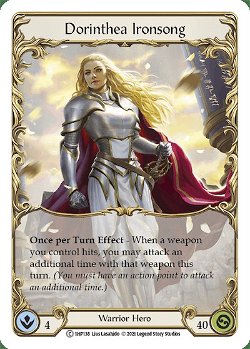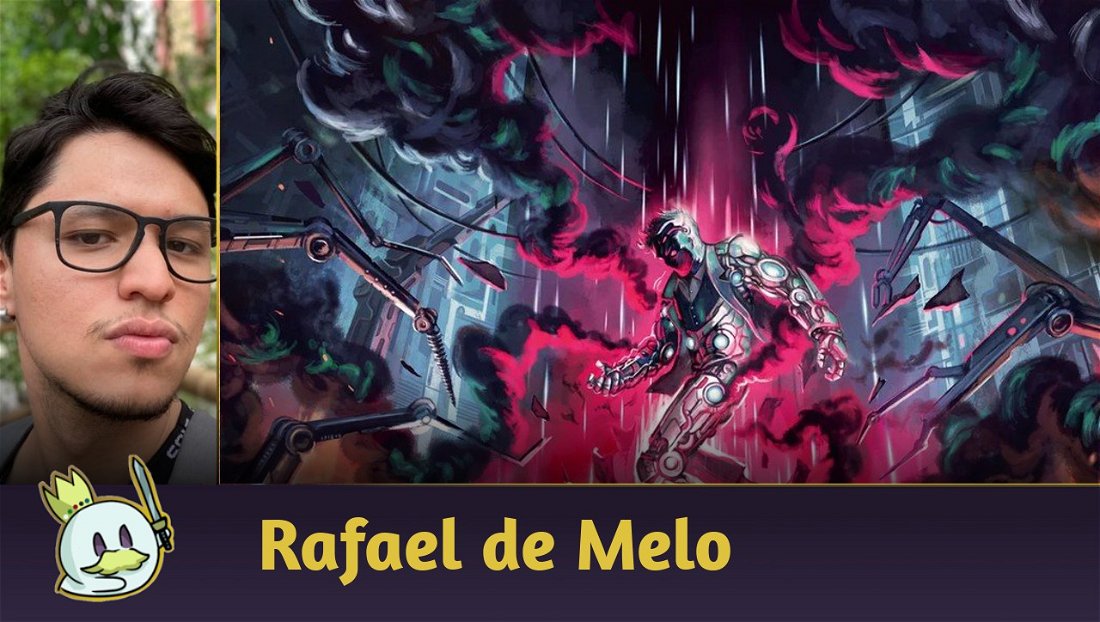Introduction
Players at the Pro Tour: Los Angeles prepared a lot for us. It was clear to see how Heavy Hitters also greatly impacted the meta: Kayo, Armed and Dangerous became one of the best decks in the format, Victor Goldmane, High and Mighty became an excellent Guardian, and Kassai of the Golden Sand once or twice has stolen a few tournaments. However, an old hero got incredible support cards and developed a new way to play: Dorinthea Ironsong!
Even though she wasn't the most popular deck at the Pro Tour, two players managed to bring her all the way to top 8 with the same strategy, and one even made it to the finals.
So, today, let's figure out how to play with this deck and understand it!
The Many Versions of Dorinthea

Dorinthea Ironsong is one of the first Flesh and Blood heroes. Released in Welcome to Rathe, she is known for surprising those who don't know what her game plan is, or those who disrespect the potential of her signature weapon, Dawnblade.

Because it puts many counters on itself, a badly blocked Dawnblade may snowball and make it impossible for your opponent to deal with all its damage. Cards like Ironsong Pride, Steelblade Supremacy, and Glistening Steelblade only make it even stronger. I could write an entirely new article solely explaining how to fight this strategy and how powerful it may be.
However, your opponent can play around it if they have a good read on the game, know how to handle Dawnblade, and also progress their game plan. And that's how you'd play Dorinthea until Dusk Till Dawn came along.

Decimator Great Axe originated a new strategy for Warriors: a fatigue strategy that abused the fact this card halved the defense of the first card that blocked it each turn, which made cards like Sink Below (1) or Unmovable (1) worse. Additionally, cards like Steelblade Shunt (1) and Felling Swing (3) gave this strategy the tools it needed to play a fatigue-style game plan.
So, we get to Heavy Hitters, which brought new support cards for Warriors, and, with it, a new strategy for Dorinthea - one based on Hatchets.

These Hatchets were released in Monarch and got some support in this same set, but their lists didn't have the tools they needed to perform well in Classic Constructed. So far, not even Dorinthea Ironsong and neither Ser Boltyn, Breaker of Dawn used these weapons well, but the new Heavy Hitters set brought new cards that significantly helped this strategy.
The Deck
For this deck tech, we'll analyze Max Klein's list, one of the Pro Tour: Los Angeles finalists.
Hatchets: Old Friends, New Strategies
As we mentioned, this strategy focuses on pure attrition; it can be defensive when you need to, but it is also quite aggressive when there's an opening.
Obviously, this deck centers around Hatchet of Body and Hatchet of Mind. Each one gains one power if the last attack that turn was the other weapon, but, thanks to Dorinthea's ability, we can attack with them an extra time that same turn. This means we can attack up to three times per turn.
Additionally, the fact they're axes makes them relevant to some interactions.
Actions
Warriors heavily focus on Attack Reactions, and some Actions actively help their game plan:

The first challenge this deck will have is to create ways to grant go again to its weapons (considering Dorinthea won't give you this), so you need a wide array of cards that allow you to grant go again.
Hit and Run (1) is quite flexible. Even though you'll prefer to use it as your first attack, it is also excellent when you use it as your second weapon as it will get even more power. Still, you can also use some other tricks. Because your second weapon will have go again, you may attack again with the previous Hatcher or fit in Command and Conquer (1).
Quite safely, Spill Blood (1) is a finisher, and one of the most powerful in this list. Besides granting two power to your Hatches (so the first attacks for four, and the second for five), granting them Dominate is what makes this card so threatening and puts your opponent in an uncomfortable situation.
Like Spill Blood (1), Spoils of War (1) is a powerful card that gives you your first go again and on-hit effect. Though it doesn't use Copper as masterfully as Kassai of the Golden Sand, it may improve a hand full of blue cards.
The latest common card, Goblet of Bloodrun Wine (3) has proved to us it is one of the new Warrior favorites. Its Agility and Vigor may only be useful on the following turn, but the fact it is a blue card that costs zero justifies this "delay", and also gives it a lot of value.
The other Actions and Attack Actions deal with more specific situations - we'll explore them a bit more when we talk about matchups.
Non-Action Cards

Besides Actions, some Attack Reactions also give go again to your weapon. Blade Runner (1) is mandatory for any deck that uses 1-handed weapons, so that's why this list uses all copies of this card in all colors available. Additionally, Glint the Quicksilver is also in this list because it fundamentally gives you go again; however, it may give you even more value with its Reprise ability.

The other Attack Reactions will help you deal more damage or buff the rest of your turn. The new set brought us Blade Flurry (1) and Shift the Tide of Battle (2), which were excellent additions to this list. While Blade Flurry (1) is exceptional in strategies that focus on two weapons, Shift the Tide of Battle (2) gives you go again and guarantees it for your next turn.
In the Swing (1) is an old friend of these strategies as well. It can be a late game threat or just deal more damage on your second attack.

Take it on the Chin (1) makes up the defensive portion of this deck, alongside Sink Below (1), Fate Foreseen (1) and Oasis Respite (1), but it stands out because it is an Instant (which means it can go around cards with Dominate), and also creates an Agility. This will guarantee you go again for your next turn.
Equipment
This list uses the standard equipment for this class, but there are a few picks that were tailor-made for this strategy.

We mentioned in several articles already how Crown of Providence is excellent as a head piece, both because it filters your hand when you need to, and because it fixes a bad arsenal. However, the new set brought a new alternative to this card. Balance of Justice is outstanding as an option in decks that use (but aren't restricted to) Bloodrush Bellow (2) or Art of War (2). This already makes this new equipment card both a staple and a viable alternative to Crown of Providence.

For the chest, there's nothing better than the good old Fyendal's Spring Tunic. As this list plays many turns and focuses on a longer game plan, this card offers you a resource to attack with a Hatchet "for free", or also play a Steelblade Shunt (1) without forcing you to pitch a card.

Braveforge Bracers is still the best option when compared to Ironsong Versus. Besides Battleworn, you can make your weapon's second attack reach breakpoint if you have any resources lying around.

This is an old friend of Kassai, Cintari Sellsword players. Valiant Dynamo is one of the most important equipment cards in this entire deck, not only because it stops breakpoint attacks, but also because it is vital in longer games (as it is common in Classic Constructed). Its simple effect, which removes a counter from it, may save you a lot of health as the game goes on, and that makes it a must for this deck.

In addition to all of this, this list has the classic Nullrune kit for matches in which you may get hit with Arcane damage, such as against Runeblades and Kano, Dracai of Aether.
Overall Strategy and Gameplay
This deck's strategy is quite simple: every turn your goal will be to attack with one of the Hatchets, give it go again and attack with the second (which will deal more damage thanks to its effect or cards like Blade Runner (1) or In the Swing (1)). On a big turn, your second attack will also have go again, and you can finish the game with some Attack Action or your turn's first Hatchet thanks to Dorinthea's ability.
Because you'll deal mostly vanilla damage (this means you won't use any on-hit effects) and play short sequences, you won't be able to be extremely aggressive with this deck. Additionally, as you're very dependent on giving go again to your attacks and the way you'll use cards like Spill Blood, the longer the game is, the worse the deck is, and you may be at risk of being fatigued. The deck itself doesn't have any secrets or complex plays. It heavily focuses on value, and on playing the most optimal play you have in hand.
Matchups and Sideboard
As we commented before, some cards are more specific, and you'll only use them against certain decks:
- Balance of Justice and Hold the Line (3) will deal with decks that draw two or more cards on the same turn (like Brutes, Ninjas, Dash I/O and Prism, Awakener of Sol);
- Amnesia (1) will get in the way of any opponent that cares about names. It will deal specifically with Katsu, the Wanderer because it will ruin their combo turns, but it is very useful against Vynnset, Iron Maiden as well;
- Cleave (1) and Down and Dirty (1) will deal with Prism, Awakener of Sol (and, in the context of the Pro Tour, also Dromai, Ash Artist);
- Oasis Respite (1) is useful when we want to either fatigue other decks or stop a Kano, Dracai of Aether combo.
Final Words
Dorinthea Ironsong is one of the game's original heroes, and therefore has been here for a long time. Because she had below-average cards, she spent a long time forgotten with Dawnblade; however, the new set gave her a breath of fresh air. It changed her strategy from snowball to a longer game plan, and she has become strong enough to make up a very solid tempo deck and become a Pro Tour finalist.
Thank you for reading, and see you next time!















— Comentários 0
, Reações 1
Seja o primeiro a comentar